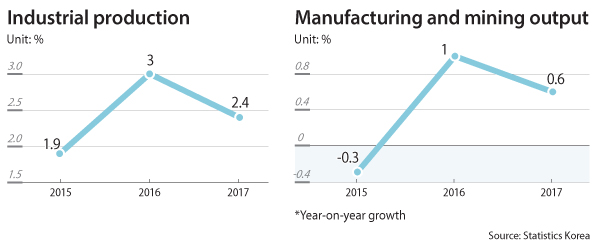Industrial output, led by investment, surges

Factory operations were at their lowest since the Asian financial crisis. One of the key factors was diplomatic tension between Seoul and Beijing over a U.S. missile defense system on Korean soil that led to a Chinese boycott of Korean products. As a result, sales of cars and cosmetics - both Korea’s fortes in China - fell.
Overall industrial production rose 2.4 percent in 2017 compared to the previous year, according to Statistics Korea on Wednesday. While output in the manufacturing and mining industry went up just 0.6 percent, consumption raced ahead at 2.7 percent and investment surged 14.1 percent.
The modest bump in manufacturing largely came from growing demand for electronic parts like semiconductors, which helped major conglomerates Samsung Electronics and SK Hynix achieve record performance last year.
But the growth was limited by other sectors that struggled, namely cars and cosmetics. As a result, the factory operating rate came to 71.9 percent, a 0.7 percentage point drop from a year ago. The figure, which measures how much facilities are utilized to their full capacity, was the lowest since 1998, when the factory operating rate was at 67.6 percent.
The trend was also evident in monthly figures for December, when manufacturing and mining output fell 6 percent from the previous December. This caused overall production that month to dip 0.7 percent.
“Shipbuilding and offshore plant construction continued to struggle,” said Eo Woon-sun, director of industrial statistics at Statistics Korea, “while automotive sales were sluggish.”
Strikes at the country’s biggest automakers, Hyundai and Kia, affected factory operations, he added.
Separate figures from the Korea Customs Service showed overseas sales of Korean cars plummeted in the fourth quarter. Exports between October and December amounted to $9 billion, a 16.2 percent drop from the previous year. It was the sharpest fall since the third quarter of 2016, when exports plummeted 17.4 percent.
The service industry, on the other hand, grew 2.5 percent but mostly thanks to the financial industry while restaurants and lodging businesses struggled. Eo attributed the sluggish growth in restaurants and lodging to the rising number of Koreans living alone.
“Restaurants and lodging businesses are usually sensitive to the economy,” the statistics director said, “but we have also considered changes in consumption, with more people eating and drinking alone and having a higher preference for convenience store food.”
This trend was evident in consumption figures. Consumption rose 2.7 percent, with online shopping leading sales growth at 13.3 percent, followed by convenience stores with 12.7 percent growth. Sales at discount supermarkets rose 5.6 percent, but department stores continued to struggle with a 2.6 percent drop. Small stores also saw a 0.9 percent dip.
Investment grew last year, especially in electronics, telecommunication and audiovisual components. Total investment last year grew 14.1 percent, with investment in the above area surging 27.9 percent.
Investment in construction also saw a 10 percent jump largely thanks to sharp recovery in the first half of last year. First-quarter investment rose 17.9 percent and increased more than 13 percent during the second and third quarters.
But after the government clamped down on the real estate market with tough regulations to cool the market, investment dipped 1.6 percent.
BY LEE HO-JEONG [lee.hojeong@joongang.co.kr]










with the Korea JoongAng Daily
To write comments, please log in to one of the accounts.
Standards Board Policy (0/250자)